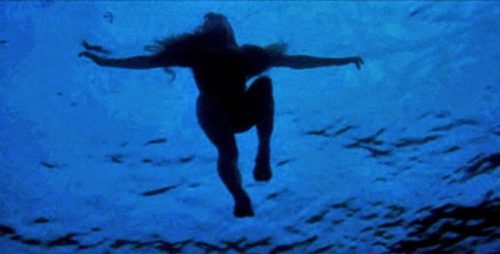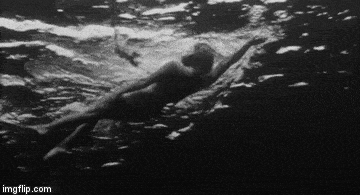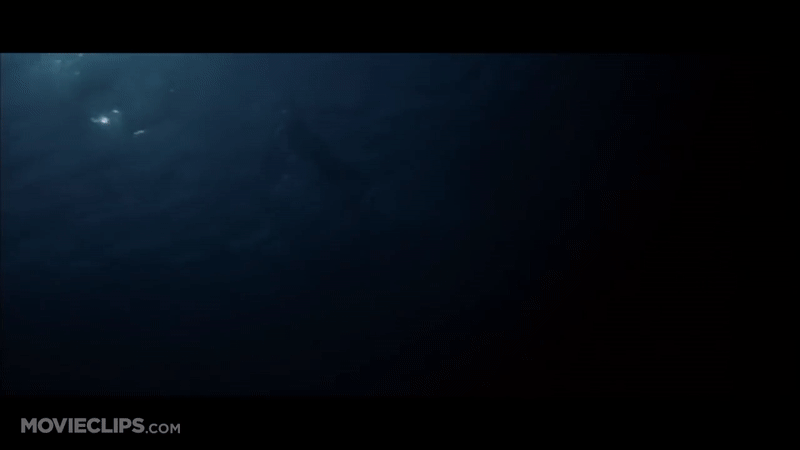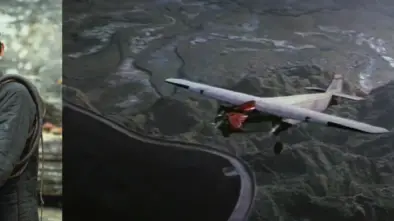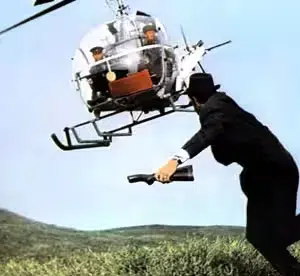Shark POV: How ‘Jaws’ Improved On The POV Shot Used In ‘The Creature From The Black Lagoon’
Steven Spielberg borrowed the underwater POV shots from the 1950s Universal monster movie but eclipsed them with confident and beautiful cinematography–and masterful pacing.
Chrissie Watkins, a resident of Amity island, strips off her clothes. In the twilight, we see her curvy silhouette dive into the calm sea for a moonlight swim. Her drunk, but friendly, pursuer collapses on the beach, unable to join her. As Chrissie glides through the water, the audience suddenly becomes aware of a presence. As John Williams’ terrifying score begins, and the camera moves rapidly up towards Chrissie’s feet, we suddenly realize we’re seeing her through the eyes of a predator–a killer shark. For a few seconds, the hapless swimmer is dragged back and forth through the water before she is pulled beneath the waves. There is silence again. The sea is still, with no evidence of the horrific scene that occurred moments before.
Today, over forty years on, the opening scene of Jaws remains the most unforgettable and terrifying opener on film. Not once do we see the shark. No fin, no tail. Nothing. Turning the camera into the shark’s POV was a masterstroke by the then 26-year-old Steven Spielberg. It seems like one of those techniques planned meticulously in pre-production, but as is often the case on film locations, some of the best ideas are born out of a problem, on the fly. For most of the shoot, the mechanical shark malfunctioned forcing Spielberg to turn the camera into the shark’s POV. In conjunction with the editing talents of Verna Fields and the music of John Williams, turning the camera into the shark’s POV was responsible for making Jaws a horror classic.
And this is where the official story ends.
But what is little known, and not talked about, is the obvious influence Universal’s 1954 monster movie The Creature From The Black Lagoon had in creating Spielberg’s camera technique. When the film’s damsel, Kay Lawrence (Julie Adams), takes a dip in the lagoon, the audience is first introduced to the creature, Gill-man, and we get some shots of Kay from beneath the water that look very similar to the underwater shots of Chrissie swimming in Jaws.
As we’ll see, this isn’t plagiarism. The fact that old films influence filmmakers is well-known. They find scenes or even a single shot that either inspire new approaches or improve on what the original film intended. The latter is certainly true with Jaws. Spielberg’s pacing–and his assured use of the camera–separates Spielberg’s POV technique from the underwater scene in The Creature From The Black Lagoon. Have a look for yourself.
Breaking Down the Awkward POV Shots in The Creature From The Black Lagoon
If you look closely, Creature’s underwater scene is awkward; it frequently moves back and forth between third-person and shots that appear to be the Creature’s POV. I say it appears to be the Creature’s POV because cinematographer William E. Snyder is not confident in using it.
You can see what I mean from an analysis of two sequences of shots from the scene.
First, let’s look at the problematic shot that first reveals Gill-man to the audience.
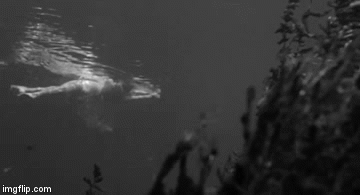
The first two GIFs above are actually one continuous shot in the final footage. From the left, we see a nice handheld shot of Kay swimming in the distance. At first, the shot seems to be from Gill-man’s point of view, until, as the camera pans to the right, Gill-man comes into the shot. This produces a slight visual dissonance because the shakiness of the handheld camera gives an impression of voyeurism–like we are watching Kay through the creature’s eyes. This voyeurism is established from the very first underwater shot of Kay swimming on the surface (below).
As director Jack Arnold claimed ” [the underwater scenes] plays upon a basic fear that people have about what might be lurking below the surface of any body of water. You know the feeling when you are swimming and something brushes your legs down there – it scares the hell out of you if you don’t know what it is. It’s the fear of the unknown. I decided to exploit this fear as much as possible.”
Unfortunately, the impact of what Arnold was trying to achieve is reduced by showing Gill-man in third-person.
Filming the correct angle of Gill-man’s eye line also proved difficult for the cinematographer, as the next set of GIFs demonstrate.
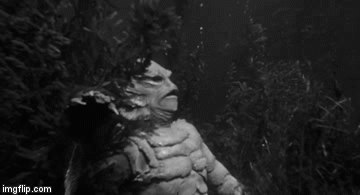
Gill-man is hiding in the weeds looking at Kay, but his eye line is considerably lower than the steep camera angle of Kay swimming on the water’s surface, which is from his POV. This incorrect eye line is reinforced by the location of Gill-man behind the weeds as shown in the GIF below.

Next, there is this rather long sequence of Gill-man following Kay and closing in on her. The scene culminates with a focus on Kay’s feet.

Gill-man touches Kay’s foot, and then we see a reaction from Kay. And then something unexpected happens: Gill-man flees, and Kay dives under to see what brushed past her foot.
What becomes clear from this breakdown is the awkward transition from third-person to POV, and the considerable number of shots wasted in creating the scene. The result is poor pacing. If Gill-man remained unseen, and we only saw Kay through his eyes, then considerably fewer shots would have been needed and the scene would have produced more psychological tension.
Spielberg’s Masterful Use of the Camera as Shark POV
Twenty-one years later, Spielberg would do better. While Spielberg learned much from the master of suspense Alfred Hitchock, it was the combination of music, editing, and the moody and beautiful cinematography of Bill Butler which helped elevate the psychological tension of turning the camera into the shark’s POV.
As you watch the opening of Jaws, notice the three stages of the attack which mirrors the progression of the underwater scene in Creature: the shot of the swimmer from underneath the surface; the creature moving closer to its victim; and the creature closing in on the victim’s feet. Also, note the far more elegant economy of shots used by Butler and Spielberg, which gives this scene significantly better pacing than the underwater scene in Creature.
The opening scene in Jaws has a similar structure to the scene of Kay swimming in The Creature From The Black Lagoon. The camera focuses on the female swimmer the whole time. As in Creature, the opening scene in Jaws begins in third-person and transitions to POV shots. But there are no awkward transitions from third-person to POV. In fact, Butler deftly transitions from third-person shots of Chrissie to the shark’s POV in a simple, yet effective way. Because the shots of Chrissie above the water are third-person, Butler smoothly transitions from third-person to shark POV in the first underwater shot (below).
This is how Butler achieved it. The first underwater shot is a wide shot from the deep of Chrissie swimming from right to left. The camera pans following her movement, which doesn’t necessarily suggest a POV shot. But then as she moves to the left of the frame, the camera rises closer to the surface. As the camera rises, which you can see in the GIF below, the camera (and therefore the frame) twists around clockwise to simulate the shark’s body (and therefore, its field of vision) turning and changing direction. The camera is now following Chrissie. This is the first suggestion we’re viewing Chrissie through the shark’s eyes.
In one continuous shot, Butler gave us the first underwater shot and moved the camera to where the shark is following Chrissie. In comparison, Creature achieved the equivalent in over a dozen shots.
After a couple more shots of Chrissie above the water, there is one final shot of the camera closing in on her feet. Only two underwater shots (and therefore only two shots from the shark’s perspective) are used in this scene. Yet, if you ask anyone, it is the shark’s POV that is most memorable. The scene is economical, fast, and deadly, the product of a confident cinematographer and a good editor and composer.
Perhaps, this is why few remember the original source, The Creature From The Black Lagoon.

